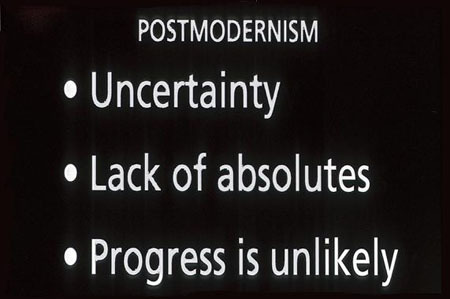Recently, storyteller Eric James Wolf turned the tables on me. I’ve conducted more than 57 Q&As with story practitioners — and now Eric has done a Q&A with me. I thought it would be worthwhile to excerpt some of it here because it explains some of my philosophies and approaches with this blog.
In this entry, Eric had asked me about the relationship between storytelling and postmodernism.
I view the current storytelling movement as an outgrowth of postmodernism. Postmodernism is characterized by critique, irony/ionic humor, mockery, parody, playfulness, disorientation, things that are symbolically rich and meaningful, multiple perspectives, conflict, the discontinuity of traditions, contradiction, ambiguity, paradox, metaphors, a strong aesthetic dimension, diversity and multiplicity, fragmentation, as well as questioning pre-established rules, values, expectations, right vs. wrong, good vs. bad, and underlying faith in reason and science.
In part, story becomes a way to make sense out of and find meaning in fragmented postmodern life.
Postmodernism means seeing organizations as texts, narratives, discourse, stories. David Boje, arguably the scholar who has most significantly connected storytelling with postmodernism, writes that “Stories are not indicators [of an organization], they ARE the organization.”
Boje writes:
The postmodern turn has several key method assumptions. First, humans as storytelling animals act toward their organization and environments based upon their storied interpretations of self, other, organization, and environment. Second, story making is a collective process of social interaction in which story meanings change over time. Third, story meaning changes with the context of the telling as storytellers select, transform, and reform the meanings of stories in light of the context of the telling. Fourth, in [storytelling organization] theory the individual is part of the collective enterprise of constructing and transforming stories told to the world and stories of the environment being constructed. This is different from a structural-functionalist model of organizations in which story functions as measures of variables of an abstract structure. Fifth, the inquirer is a story-reader who upon entering the story-making world changes the story-making processes by being there at all.
Postmodernism also means fusing modern techniques with traditional concerns. We can never get away from traditional oral narrative culture because we think in story; that’s how our brains are wired. But a postmodern view says that story does not come from an authority on high but belongs to everyone. It’s collective and distributed, and many people and perspectives participate in constructing stories (think about social media and blogs). Postmodernism also means rejecting the idea of an objective “reality;” there is only the reality we construct with others through discourse — by telling our stories.
Probably my best attempt at connecting postmodern storytelling with traditional oral narrative culture is in an essay I wrote as part of my PhD program.
Having said all that, I am less interested in postmodernism than I used to be. Postmodern theory provided my entry point into storytelling, and [this] blog still carries the tagline “Kathy Hansen’s Blog to explore traditional and postmodern forms/uses of storytelling,” but it’s not a big part of my current thinking.
